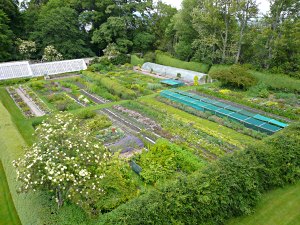Back to school – hooray! Last week’s snow, frost and lack of trains, planes and automobiles kept us from the shimmery gates of the RBGE. Today we bundled back in and let the sun shine gloriously upon us through a sea of snow banks.
Our previous homework assignment had been to ‘draw the constellations’ in readiness for today’s topic – Biodynamic Gardening. Great rolls of lining wall paper were drafted in and I spocked out Hugh’s ancient protractor and Rosie’s bag of coloured pencils to accomplish the task.
Fortunately Fate has smiled on me as I had found a most wonderful book – Celestial Charts ~ Antique Maps of the Heavens (by Carole Stott) as Oxfam earlier in the week. Having spent the week reading it and not doing my homework, I decided I should refocus and opened my Faire son Potager a la Lune. This was a mistake - I had to read that too and by the time I got through it, was thoroughly bewildered by the multiplicities of lunar considerations one should take into account before sowing, cultivating or harvesting a bean that I was ready to throw the trowel in…
Duncan Ross, however calmly led us through the labyrinth of Tropical, Sidereal and Biodynamic gardening techniques that have emerged from Rudolph Steiner’s seminal work on the subject. Consulted by farmers and producers in the early 1920’s Steiner's philosophy was that the sun, stars and moon all affect our lives and influence growth, health and productivity of all living things around us.
The Biodynamic movement has its roots (sorry) in both ancient planting methods and in new interpretations of the effects of the lunar and solar calendars. More precisely, how the moon passing through the constellations affects life on Earth as well as it’s own gravitational pull.
In practical terms, Steiner’s philosophy also involves a bit of ancient lore and (some would argue) mysticism. Where organic gardening focuses on the health of the soil, biodynamic takes it a bit further and gives consideration to the nature of each plant, the biodiversity of the garden, associated animals and their enhancement with cosmic preparations.
To illustrate this we clambered up to our practical beds where we filled a cow’s horn with fresh manure and buried it 3 feet deep, there to mature and gestate. Come March we will dilute the contents of the horn with water, potentise it and disperse this across the newly dug beds. Throughout the year we will also add floral water potions to the compost to give it true bio dynamic qualities.
We ended our day with a dose of hot ginger tea and explored the beauty of Floris Books’ Stargazer’s Almanac, which shows the night skies from an Edinburgh perspective.
Happy Hogmanay!
























